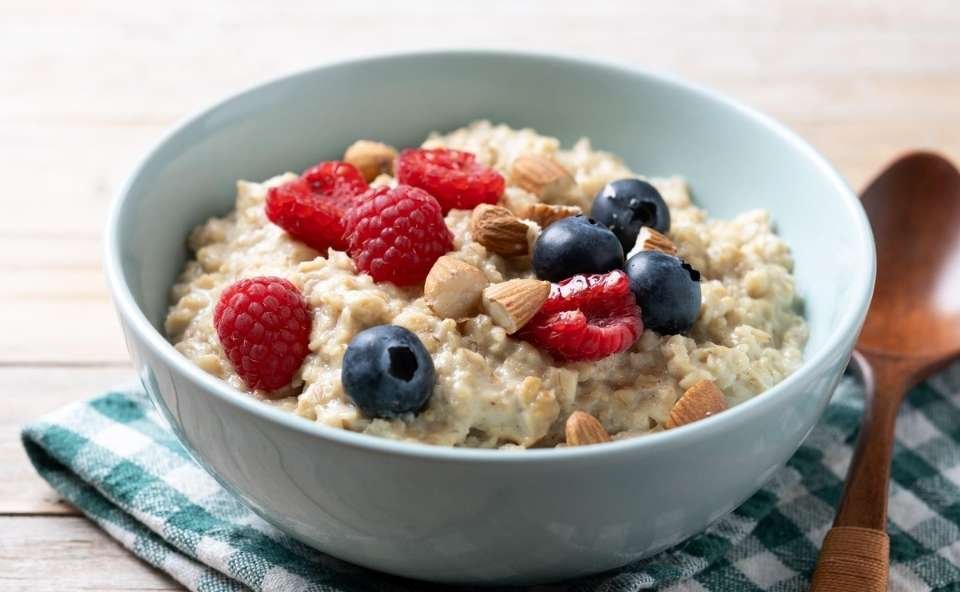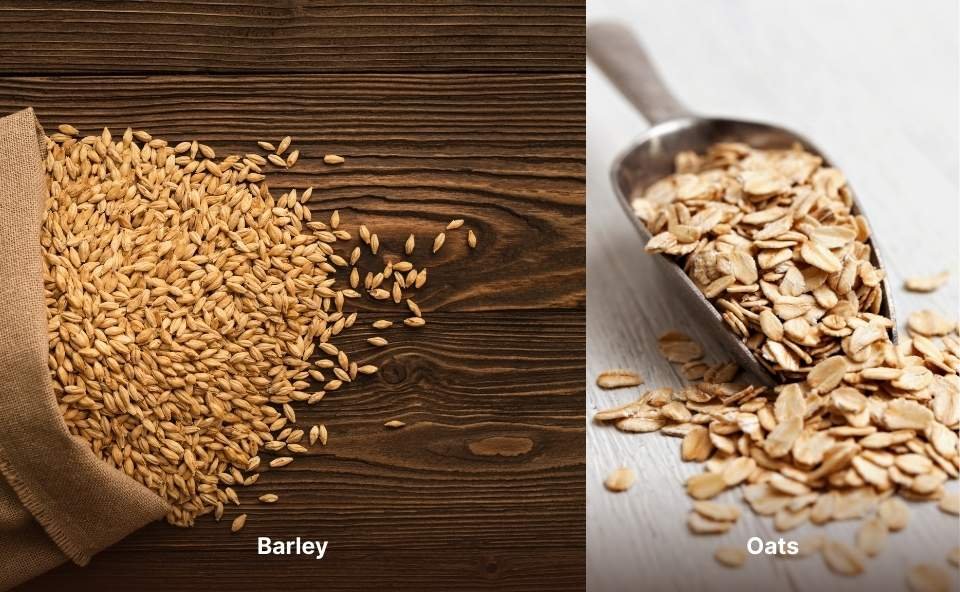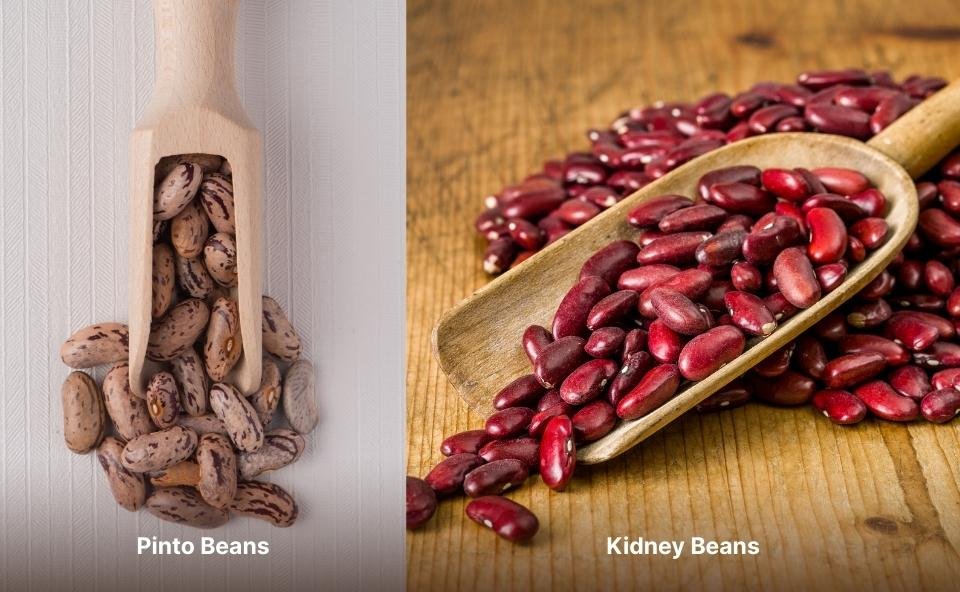Growing up, my grandmother always had a kitchen filled with the aroma of baked bread and simmering soups. She believed in the power of grains, and every meal had a touch of either oats or barley. She would say, “These are the staples of a healthy life.”
At the time, I didn’t quite understand why she preferred them over processed foods. But as I started exploring their nutritional benefits, I realized she was ahead of her time. These two whole-grain wonders are packed with fiber, vitamins, and minerals, making them an inexpensive, nutritious choice for daily consumption.
One memory that stands out is when she taught me how to cook a classic bowl of oatmeal on a cold morning. She let me pick my toppings, from creamy honey to crunchy nuts, explaining how oats are a go-to ingredient for a filling breakfast. On the other hand, she used barley to create a hearty porridge or toss it into salads for a chewy, nutty texture.
I was fascinated by the differences, while oats had a mild taste and smooth consistency, barley added depth to dishes. When I travelled to some countries for work, I noticed that different cultures used these grains in unique ways—Asians loved barley drinks, while Europeans made delicious bread and beverages with them.
Now, as someone who enjoys comparing flavors and preparing new recipes, I find myself reaching for these grains just like my grandmother did. Whether it’s a warm bowl of oatmeal, a hearty barley stew, or a baked snack bar, I love how they provide endless culinary applications. They’re also a great way to feed your body with essential nutrients while keeping meals exciting.
If you haven’t yet tried them, I’d say start today. After all, good food isn’t just about taste; it’s about tradition, health, and making memories around the table.
Varieties
Before I started experimenting in the kitchen, I never realized how many different varieties of these grains existed. It wasn’t until I stood in a grocery aisle, staring at shelves packed with options, that I understood just how diverse they are.
Barley
I’ve always been fascinated by how different types of barley can completely change the texture and flavor of a meal. Over time, I’ve tried various kinds, each with its unique qualities. Choosing the right one depends on what you’re cooking and how much consumers value convenience over traditional preparation.
- Hulled Barley; One of my favorites is this because it’s the least processed. The outermost shell of the grain is removed, but the chewy texture remains. It takes the longest to cook, making it perfect for slow-cooked soups and stews. If you enjoy a hearty bite, this is the best choice. These are also known as barley groats have a natural, nutty taste, adding a rich depth to dishes.
- Pearl Barley; For a little quicker option, these are best. Pearl Barley goes through extra processing, where another layer is removed, making it a softer variety that cooks much faster. I usually find it easily in the store, and it’s my go-to when I need a nutritious yet easy-to-make grain for meals.
- Quick Barley; is a lifesaver when I’m short on time. It’s partially cooked and then dried, so it has a quicker cooking time. This comes in handy when making last-minute dishes without losing the wholesome taste of barley.
- Barley Flakes; For breakfast, I like using these because they resemble oatmeal flakes, as both are flattened into thin slices. They make a great alternative to oats, especially when I want something different.
Curious how barley stacks up against other ancient grains? Don’t miss our comparison on barley vs buckwheat—it’s a helpful guide if you’re deciding which wholesome grain to try next! 🌾
Oats
Oatmeal has always been my go-to breakfast because it’s comforting and versatile. Depending on how the grains are processed, the texture and taste change, making each type unique. Some mornings, I crave a hearty, chewy bowl, while other days, I just need something quick and smooth.
- Oat Groats; When I have extra time, I love cooking oat groats—the whole, unprocessed form of oats. They are tiny and have the chewiest texture. Though they take the longest to cook, the rich, nutty taste makes the wait worth it.
If you’re curious to learn more, here’s our complete guide about oat groats—it’s everything I wish I knew when I first started using them!
- Steel-Cut Oats; For a quicker but still satisfying option. These are cut into pieces with steel blades, cooking faster while keeping a slightly firm texture. Paired with honey and fruit, they make a warm and filling meal.
- Old-fashioned or Rolled Oats; These are the best choice for busy mornings. They are steamed and flattened into flakes, cooking quickly while still having a nice bite. They’re my top choice when I need a fast yet wholesome breakfast.
- Instant Oats; If I’m really short on time, these oats save the day. These rolled oats are cut into smaller pieces, so they cook in just minutes.
- Oat Flour; When baking, I love using this flour, which is made by grinding Oat groats into a fine powder. It gives my pancakes and bread a soft texture and a slightly sweet taste that everyone enjoys.
If you enjoy learning about oats like I do, you might also love seeing how they stack up against other grains. Don’t miss our detailed comparisons like Oats vs Quinoa and Oats vs Buckwheat—perfect for discovering which one fits your lifestyle best!
Appearance
I’ve always found it fascinating how different barley and oats look and feel. A pile of dried grains might seem ordinary, but when you run your fingers through them, the contrast becomes clear.
- Uncooked barley, especially hulled barley, is thick, hard, and oval-shaped, with a tan or yellowish hue, feeling firm and substantial. On the other hand, rolled oats are thin and almost paper-like. I remember the first time I handled them, surprised by how easily they could be broken or torn apart.
- When cooked, both grow in size and change color, but their textures couldn’t be more different. Barley remains granular, keeping its structure, making it perfect for soups, while oats turn stickier and into a soft mush that blends together effortlessly. Whether I’m craving a hearty bite or a comforting bowl of porridge, I love how these grains each bring something unique to the table.
Taste
I’ve always enjoyed the contrast between barley and oats when it comes to flavor and texture.
- Barley has a slightly chewy bite with a nutty and mildly tart taste, making each grain feel rich and satisfying. It can be a little sticky, but the grains mostly stay individual, giving it a hearty feel.

Boiled Barley.
- Oats, on the other hand, have a mild, warm taste and become much mushier when cooked, creating a smooth and comforting consistency.

Oatmeal with some Raspberries, Blueberries, and Almonds.
Whether I want something firm or soft, both grains bring a unique experience to the table.
Nutritional Benefits
Growing up, I always saw my grandmother cooking oats for breakfast, while my uncle swore by barley for its rich nutritional value. Both are whole-grain foods, but they offer different health benefits.
Barley has more dietary fiber, especially insoluble fiber, which helps digestion, while oats are loaded with soluble fiber, known for lowering cholesterol and improving heart health.
If you’re worried about cardiovascular diseases, adding oats to your diet can be a smart choice.
Once, I decided to compare their benefits myself. I noticed that oats kept me full longer, thanks to their high protein content and essential nutrients like manganese, phosphorus, magnesium, vitamin B, and iron. On the other hand, barley had its strengths, being rich in thiamine, selenium, B vitamins, folate, potassium, zinc, copper, and vitamin B6.
It turns out my uncle was right: barley provides lasting energy, but oats are great for muscle health.
The real test was in the taste. While my grandmother’s oatmeal was comforting, my uncle’s barley soup had a deeper, earthy flavor. Both grains are naturally low in sugar, but I had to be careful with the extra brown sugar, maple syrup, honey, or dried fruit in my oats. Whether in a hearty meal or a warm breakfast, these grains provide important macronutrients like carbs, total fat, and saturated fat, along with powerful antioxidants.
Now, I enjoy both, knowing each has a unique role in my diet.
Here is a breakdown of the nutrients in both grains.
| Component | Oats (per 100g) | Barley (per 100g) |
|---|---|---|
| Calories | 389 kcal | 354 kcal |
| Total Fat | 6.9 g | 2.3 g |
| Saturated Fat | 1.2 g | 0.5 g |
| Protein | 16.9 g | 12.5 g |
| Carbohydrates | 66.3 g | 73.5 g |
| Fiber | 10.6 g | 17.3 g |
| Calcium | 54 mg | 33 mg |
| Iron | 4.7 mg | 3.6 mg |
| Magnesium | 177 mg | 79 mg |
| Potassium | 429 mg | 280 mg |
Gluten Content
As someone who loves oatmeal, I always check if it’s certified gluten-free because while oats are naturally free from gluten, they’re often processed in shared facilities with barley and other grains, causing cross-contamination. This makes them unsafe for people with celiac disease, who must avoid even small traces of gluten.
The key difference is that barley does contain gluten, so if you need to consume only safe options, always choose certified oats.
Blood Sugar Impact
I always check the glycemic index (GI) of grains before adding them to my meals, as it helps measure how a food affects blood sugar. Barley has the lowest score of 28, meaning it won’t spike glucose levels. On the other hand, oatmeal has a moderate GI, ranging from 42 to 55, depending on the variety and cooking method. Thanks to its fiber, it keeps energy stable and helps prevent rapid spikes in blood sugar.
However, both are high in carbohydrates, making them unsuitable for a keto diet.
Potential Side Effects of Consuming Oats and Barley
I’ve always been a fan of oats and barley for their health benefits, but over time, I’ve learned that they don’t suit everyone. Here are some important things to keep in mind:
Oats
- If you have trouble swallowing or chewing, oats might not be the best choice. Poorly chewed oats can create a blockage in the intestine, leading to serious discomfort.
- Regular consumption of oats may cause problems for those with disorders in the digestive tracts, affecting the esophagus, stomach, and intestines. I’ve personally seen friends struggle with this, so it’s something to be aware of.
Barley
- If you have intolerance to wheat or suffer from celiac disease, it’s best to stay away from barley. It contains fructans, a carbohydrate known to cause bloating and gas, especially in those with an irritable bowel.
- For anyone managing diabetes, barley may not be the best choice. I’ve heard from many that it can affect blood sugar levels, so a patient dealing with this condition should be cautious and possibly avoid it.
Knowing how your body reacts to different grains is key to maintaining a healthy diet. While both oats and barley have great benefits, they may not be suitable for everyone.
Cooking Time
When it comes to cooking grains, I always consider the method and cooking time to get the best results. Both barley and oatmeal can be cooked on the stove, in a pressure cooker, or using an Instant Pot.
If you’re in a hurry, oats are the faster option.
- Rolled Oats
- Time: 10 mins (Stove Top), 5 mins (Microwave), 20 mins (Instant Pot)
- Method: Boiling, steaming
- Equipment: Stove, Microwave, Instant Pot
- Time: 10 mins (Stove Top), 5 mins (Microwave), 20 mins (Instant Pot)
- Steel-cut Oats
- Time: 15 mins (Microwave)
- Method: Steaming
- Equipment: Microwave
- Time: 15 mins (Microwave)
- Oat Groats
- Time: 40 mins (Instant Pot), 1 hour (Stove Top)
- Method: Boiling
- Equipment: Stove, Instant Pot
- Time: 40 mins (Instant Pot), 1 hour (Stove Top)
On the other hand, barley requires a longer cooking time.
- Pearled Barley
- Time: 25 mins (Stove Top), 35 mins (Instant Pot)
- Method: Boiling, simmering
- Equipment: Stove, Instant Pot
- Time: 25 mins (Stove Top), 35 mins (Instant Pot)
- Hulled Barley (Unsoaked)
- Time: 40 mins (Stove Top, Instant Pot)
- Method: Boiling, slow cooking
- Equipment: Stove, Instant Pot
- Time: 40 mins (Stove Top, Instant Pot)
To cut down on cooking time, soaking the hulled version for a few hours beforehand helps. Whether you prefer the nutty texture of groats or the softness of pearled grains, choosing the right method makes all the difference.
Cost
As of March 26, 2025, I recently checked the prices of barley and oats at different US grocery stores, and it’s clear that oatmeal is the cheaper option.
At Target, I found a 1-pound bag of Pearled Barley from Good & Gather™ priced at $0.95. Unfortunately, I couldn’t find updated prices for Pearled Barley at Winco or Walmart during my search.
When it comes to Rolled Oats, I also noticed that pricing details were limited at these stores.
From my experience, prices can change frequently, so I always make sure to check in-store or online before making a purchase.
Recipes
How I Enjoy Barley and Oats
I love starting my day with a warm bowl of oatmeal, one of the easiest forms of oats to prepare. This wholesome cereal is consumed in so many ways, from simple porridge to delicious baked goods. But I also enjoy the nutty chew of barley, especially in hearty soups and refreshing salads.
Both grains are packed with goodness, and whether it’s breakfast or a savory dish, they always find a place in my kitchen. Here are some of my experiments for both.
Frequently Asked Questions
What Makes Barley and Oats Different?
The key difference between barley and oats is their growth and composition. Barley is a primary crop, while oats are a secondary crop, originally derived from a weed. Both are whole grains, but only barley contains gluten, whereas oatmeal is naturally gluten-free.
If you prefer a sweeter grain, it has been noted that barley is slightly sweeter than oats.
What Makes Barley and Oats Similar?
Both grains have a mild, flavored taste and can be used interchangeably in various cooking methods. When stored properly, they can hold their quality for up to 10 years if kept in sealed buckets with oxygen absorbers. They are commonly eaten as breakfast foods, and I often enjoy making a recipe like barley porridge topped with fresh fruit for a great start to the day.
Conclusion
After trying both grains in different meals, I’ve found that each has its own charm. Oatmeal has a softer texture, which makes it my go-to for a warm, comforting breakfast, while barley’s chewiness works great in heartier dishes.
This comparison has been an eye-opening journey, and I hope this guide has helped you choose the one that suits your taste. If you had to prefer one, which would it be? Share your thoughts in the comments!

Hi, I’m the voice behind The Bean Bite — someone who’s genuinely obsessed with beans! What started as a simple love for homemade lentil stew turned into a journey of discovering bean varieties, cooking tips, and their amazing health benefits. This site is my way of sharing that joy with you — one bean at a time.




This made my heart happy
Epic 🚀 stuff right here